
Chicano, Chicana, is an identity for Mexican Americans who have a non-Anglo self-image. Chicano was originally a classist and racist slur used toward low-income Mexicans that was reclaimed in the 1940s among youth who belonged to the Pachuco and Pachuca subculture. In the 1960s, Chicano was widely reclaimed in the building of a movement toward political empowerment, ethnic solidarity, and pride in being of indigenous descent. Chicano developed its own meaning separate from Mexican American identity. Youth in barrios rejected cultural assimilation into whiteness and embraced their own identity and worldview as a form of empowerment and resistance. The community forged an independent political and cultural movement, sometimes working alongside the Black power movement.
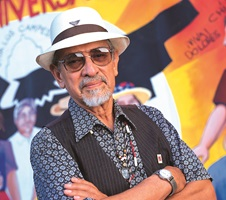
José Montoya was a poet and an artist from Sacramento, California. He was one of the most influential Chicano bilingual poets. He has published many well-known poems in anthologies and magazines, and served as Sacramento's poet laureate.
KVIE is a PBS member television station in Sacramento, California, United States. The station is owned by KVIE, Inc., a community-based non-profit organization. KVIE's studios are located on West El Camino Avenue in the Natomas district of Sacramento, and its transmitter is located in Walnut Grove, California.
The Royal Chicano Air Force (RCAF) is a Sacramento, California-based art collective, founded in 1970 by Ricardo Favela, José Montoya and Esteban Villa. It was one of the "most important collective artist groups" in the Chicano art movement in California during the 1970s and the 1980s and continues to be influential into the 21st century.
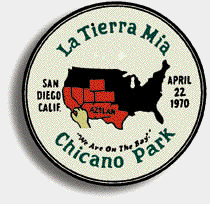
Chicano Park is a 32,000 square meter park located beneath the San Diego-Coronado Bridge in Barrio Logan, a predominantly Chicano or Mexican American and Mexican-migrant community in central San Diego, California. The park is home to the country's largest collection of outdoor murals, as well as various sculptures, earthworks, and an architectural piece dedicated to the cultural heritage of the community. Because of the magnitude and historical significance of the murals, the park was designated an official historic site by the San Diego Historical Site Board in 1980, and its murals were officially recognized as public art by the San Diego Public Advisory Board in 1987. The park was listed on the National Register of Historic Places in 2013 owing to its association with the Chicano Movement, and was designated a National Historic Landmark in 2016. Chicano Park, like Berkeley's People's Park, was the result of a militant people's land takeover. Every year on April 22, the community celebrates the anniversary of the park's takeover with a celebration called Chicano Park Day.

Gronk, born Glugio Nicandro, is a Chicano painter, printmaker, and performance artist. His work is collected by museums around the country including the Smithsonian American Art Museum.
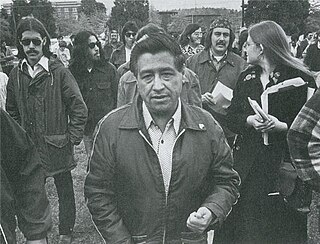
The Chicano Movement, also referred to as El Movimiento, was a social and political movement in the United States inspired by prior acts of resistance among people of Mexican descent, especially of Pachucos in the 1940s and 1950s, and the Black Power movement, that worked to embrace a Chicano/a identity and worldview that combated structural racism, encouraged cultural revitalization, and achieved community empowerment by rejecting assimilation. Before this, Chicano/a had been a term of derision, adopted by some Pachucos as an expression of defiance to Anglo-American society. With the rise of Chicanismo, Chicano/a became a reclaimed term in the 1960s and 1970s, used to express political autonomy, ethnic and cultural solidarity, and pride in being of Indigenous descent, diverging from the assimilationist Mexican-American identity. Chicanos also expressed solidarity and defined their culture through the development of Chicano art during El Movimiento, and stood firm in preserving their religion.
Los Four was a Chicano artist collective active based in Los Angeles, California. The group was instrumental in bringing the Chicano art movement to the attention of the mainstream art world.

The Centro Cultural de la Raza is a non-profit organization with the specific mission to create, preserve, promote and educate about Chicano, Mexicano, Native American and Latino art and culture. It is located in Balboa Park in San Diego, California.The cultural center supports and encourages the creative expression “of the indigenous cultures of the Americas.” It is currently a member of the American Alliance of Museums.
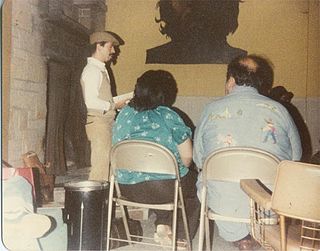
Alberto Baltazar Urista Heredia, better known by his nom de plume Alurista, is a Chicano poet and activist. His work was influential in the Chicano Movement and is important to the field of Chicano poetry.
The UCLA Chicano Studies Research Center (CSRC) was founded in 1969 to foster multidisciplinary research efforts at the University of California, Los Angeles (UCLA). It is one of four ethnic studies centers established at UCLA that year, all of which were the first in the nation and have advanced our understanding of the essential contributions of people of color to U.S. history, thought, and culture. The centers remain the major organized research units in the University of California system that focus on ethnic and racial communities and contribute to the system's research mission.
Southside Park is a neighborhood in Sacramento, California, located immediately south of Downtown Sacramento. Its official borders are R Street to the north, W-X Freeway to the south, I-5 to the west, and 12th Street to the east.
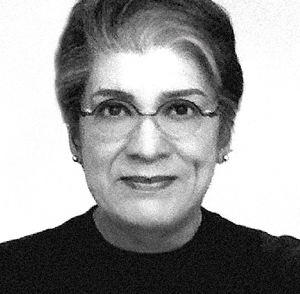
Judithe Hernández is an American artist and educator, she is known as a muralist, pastel artist, and painter. She a pioneer of the Chicano art movement and a former member of the art collective Los Four. She is based in Los Angeles, California and previously lived in Chicago.

The Chicano Art Movement represents groundbreaking movements by Mexican-American artists to establish a unique artistic identity in the United States. Much of the art and the artists creating Chicano Art were heavily influenced by Chicano Movement which began in the 1960s.
Yreina Cervantez is an American artist and Chicana activist who is known for her multimedia painting, murals, and printmaking. She has exhibited nationally and internationally, and her work is in the permanent collections of the Smithsonian American Art Museum, The Mexican Museum, the Los Angeles County Museum, and the Los Angeles Museum of Contemporary Art.
Lorraine Garcia-Nakata is an American artist who works with various mediums including pastel, charcoal, ceramics, printmaking, installation, sculpture, and paint. Her work surrounds themes of the daily life, portraiture, and realism and is known for her large scale artworks. She is a member of the Royal Chicano Air Force (RCAF) artist collective since 1974.
Juanishi Orosco is an American artist. He is known for his prints and murals associated with the Chicano Movement. He is a member and co-founder of the Royal Chicano Air Force art collective. Major American art museums hold Orosco’s work in their collections, such as the Smithsonian American Art Museum, and murals by Orosco may be found across California.
Ricardo Favela was an American artist, professor, and civil rights activist based in Sacramento, California. He was a founding member of the Chicano art collective group Royal Chicano Air Force.
Esteban Ramón Pérez is an American artist who produces multi-media paintings and sculptures. His sociopolitical artwork often emphasizes subjective memory, spirituality, and fragmented history. Pérez earned a BFA from the California Institute of the Arts in 2017 and an MFA in painting and printmaking from the Yale School of Art, New Haven, Connecticut, in 2019. Pérez’s work has been exhibited in numerous group exhibitions, including shows at Artspace, New Haven, Connecticut; Eastern Connecticut State University Art Gallery, Windham, Connecticut; Transmitter Gallery, Brooklyn; James Cohan Gallery, New York; Gamma Galería, Guadalajara, Mexico; Calderón, New York; the Arlington Arts Center, Virginia; Charles Moffett, New York; and Lehmann Maupin, New York. Solo exhibitions include Staniar Gallery, Lexington, Virginia. Pérez was selected for the NXTHVN Fellowship Program and is a 2022 recipient of the Artadia Award. He lives and works in Los Angeles, California.








